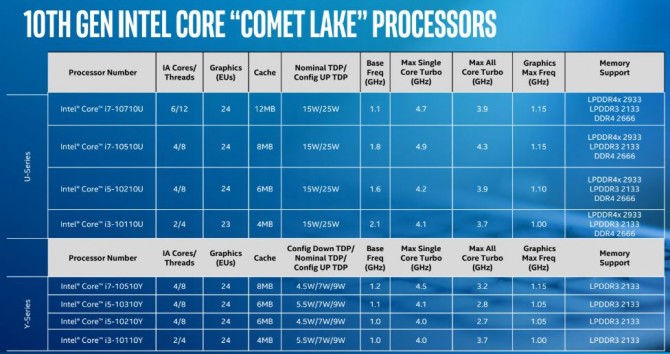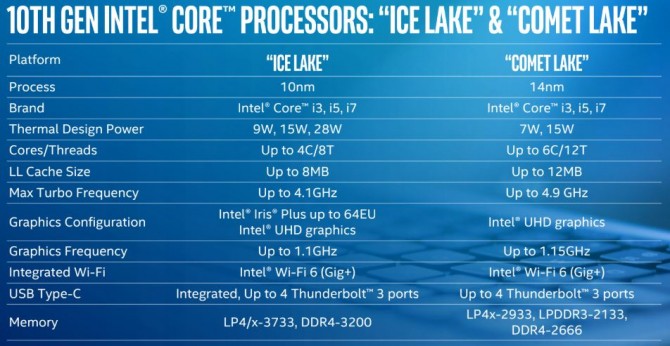Intel Has Yet Another 10th Gen CPU: Meet Comet Lake
Intel just introduced another 10th Gen processor, and things are about to get very confusing for customers.
Unveiled today are new 14-nanometer "Comet Lake" CPUs that will live alongside the 10-nanometer "Ice Lake" chips Intel released earlier this month. Yes, both of those processors are 10th Gen mobile chips and both are designed for thin-and-lightweight laptops.
To clear things up, we'll take a detailed look at the most recently announced 10th Gen Comet Lake CPUs before comparing them to Ice Lake chips.
10th Gen Comet Lake CPUs: Performance
New to Intel's CPU family are new 14-nanometer Intel Core U- and Y-series chips. Dubbed "Comet Lake," these 10th Gen chips are direct successors to the 8th Gen Whiskey Lake chips found in the latest laptops.
Comet Lake processors are all about increasing performance by boosting clock speeds. To that end, Comet Lake introduces the first U-series processor with 6-cores and 12-threads (Core i7-10710U), which has a base frequency of 1.1 GHz and a maximum single-core clock speed of 4.7 GHz.
Next-gen laptops with 10th Gen Comet Lake chips should be significantly faster than the current crop of notebooks. That's because, as Intel tells us, Comet Lake chips offer 16% greater overall performance than last-gen CPUs. That's based on benchmarks between the six-core Core i7-10710U and the four-core Core i7-8565U, the processor powering the newest XPS 13.
Sign up to receive The Snapshot, a free special dispatch from Laptop Mag, in your inbox.
Moreover, the newer chips should be around 40% faster than the previous processors when exporting files in Office 365. Intel also promises long battery life but didn't give specifics.
Graphics aren't Comet Lake's strong suit. For the best integrated graphics performance, see Ice Lake. You should expect only slightly better graphics performance over 8th Gen chips because Comet Lake CPUs are still paired with UHD Graphics.
Of course, these figures should all be taken with a grain of salt considering they were taken by Intel with a pre-production unit. Also, don't expect the same level of performance from the other chips in the Comet Lake family, especially the low-power Y-series models, which have a TDP ranging from 4.5W to 9W compared to the 15W or 25W U-series chips.
You should still expect Comet Lake processors to be faster than Whiskey Lake CPUs, we just won't know exactly how much until we conduct our own tests.
10th Gen Comet Lake CPUs: Features
Beyond raw performance, 10th Gen Comet Lake CPUs also supports a handful of futureproof features. Chief among them is Wi-Fi 6 (Gig+), the latest standard that offers faster wireless speeds, increased capacity and better power efficiency over 802.11ac (or Wi-Fi 5).
Another feature is integrated Thunderbolt 3 for charging devices, superfast data transfer and connecting to an eGPU or multiple 4K monitors. This doesn't mean that every Comet Lake-powered laptop will support Thunderbolt 3; It's still up to laptop manufacturers to decide if they want to use the connection, but Comet Lake CPUs (and Ice Lake) will hopefully make the port more widespread.
Comet Lake CPUs also support LPDDR4x, LPDDR3 and DDR4 memory speeds for up to 2,666 transfers per second (MT/s) and Intel Optane Memory H10 with SSD.
10th Gen Comet Lake Model Numbers
Unlike Ice Lake, Comet Lake CPUs will retain the conventional naming scheme we've grown accustomed to over the years.
If you're not familiar with how Intel numbers its processors, don't worry --- we'll give you a quick refresher using the Intel Core i7-10710U processor as an example.
To start, "Intel Core" is simply a brand name. From there, you have i7, or the brand modifier. These will either be i3, i5 or i7 with the higher number corresponding to a more powerful processor.
As you might have guessed, the first two numbers, or "10," indicate the generation of processor. The next three numbers (710 in this example) denote the specific model while the U (or Y) is the product line.
MORE: Best Laptop Processor: Laptop CPUs Compared
This differs from Ice Lake's naming scheme, which ends with a graphics identifier (G7, for example) instead of the product line suffix.
Intel 10th Gen CPUs: Comet Lake vs Ice Lake
What are the differences between the two new 10th Gen chips: Comet Lake and Ice Lake?
It starts with node size. Comet Lake is the next iteration of the long-running 14-nanometer chip while Ice Lake is the first of Intel's hotly-anticipated 10-nanometer node.
While that's a significant distinction, it probably doesn't mean much to the majority of consumers. Instead, think of it like this: Comet Lake processors are better optimized for demanding, multithreaded workloads whereas Ice Lake chips offer better graphics and were designed for AI software.
We'll have to wait for our benchmarking to get a better idea of the performance gulf between these chips. However, on paper, Comet Lake reigns. Comet Lake's highest-end processor has six cores and a max turbo frequency of 4.9Ghz whereas Ice Lake tops out at four cores and 4.1Ghz.
On the other hand, Ice Lake's Intel Iris Plus graphics should be better suited for games and graphics-intensive programs, like Adobe Photoshop and Premiere, compared to Comet Lake's UHD graphics. That said, the benchmark tests we conducted proved that Ice Lake still can't compete with a discrete GPU.
Ice Lake and Comet Lake both come with integrated Wi-Fi 6 and Thunderbolt 3.
Outlook
Comet Lake processors will likely be seen by some as a stop-gap until Intel can better optimize and mass produce its new 10 nanometer chips.
Until then, Intel claims that Comet Lake is the better choice than Ice Lake for users who care about raw performance. Conversely, if graphics matter more to you, Ice Lake and its Intel Iris Plus graphics should be a definite step up.
We'll be able to better compare these two 10th Gen chips once we get our hands on laptops that use both Comet Lake and Ice Lake processors, so expect an in-depth breakdown in the coming weeks.
Credit: Intel
Phillip Tracy is the assistant managing editor at Laptop Mag where he reviews laptops, phones and other gadgets while covering the latest industry news. After graduating with a journalism degree from the University of Texas at Austin, Phillip became a tech reporter at the Daily Dot. There, he wrote reviews for a range of gadgets and covered everything from social media trends to cybersecurity. Prior to that, he wrote for RCR Wireless News covering 5G and IoT. When he's not tinkering with devices, you can find Phillip playing video games, reading, traveling or watching soccer.





